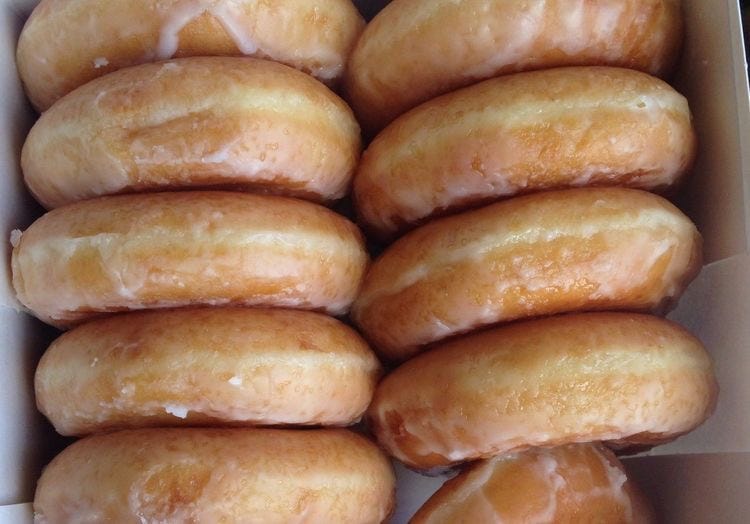Why Rhode Eats 🍩
Hailey Bieber’s Rhode has quickly emerged as a dominant player in the beauty industry, reaching $10 million in sales within just 11 days of its 2022 launch. In January 2025 alone, the brand attracted 1.8 million website visits, a testament to its ability to drive online engagement and conversion. Bieber’s success is not merely a result of celebrity influence; rather, it demonstrates a strategic use of sensory-driven branding—one that leverages consumer psychology to create an immersive digital experience.
Tapping Into Sensory Marketing
Bieber’s strategy capitalizes on a fundamental human instinct: the pleasure derived from food. Indulgent, highly palatable foods trigger dopamine, making them a powerful marketing tool. Once essential for survival during hunter and gatherer times, these foods now fuel our attraction to sensory-rich experiences, including products associated with them. Thus, by integrating food-based branding cues—such as her Glazed Donut Skin campaign and Krispy Kreme collaboration—Rhode connects its skincare products to universally recognizable sensory experiences . Research suggests that women, in particular, exhibit heightened neural responses to palatable foods, activating reward-related brain regions (Cordeira et al., 2010; Legget et al., 2018). By aligning her brand with these deeply ingrained sensory triggers, Bieber has developed a marketing strategy that is both emotionally resonant and commercially effective.
The Neuroscience of Perception and Brand Appeal
At the core of Rhode’s success is cross-modal association—the way different senses work together to shape perception—and the misattribution effect, in which individuals unconsciously transfer emotions from one stimulus to another.
Studies have demonstrated that playing classical music enhances the perceived sweetness of chocolate, reinforcing the idea that sensory input influences consumer perception (Reinoso Carvalho et al., 2016). Similarly, research on misattribution of arousal shows that environmental stimuli—such as excitement from a roller coaster—can heighten perceived attraction to the person you are with which is the same reason psychologists suggest to watch a scary movie on a first date (Meston & Frolich, 2003). Bieber applies these principles of sensory psychology to digitally-driven commerce, where traditional sensory engagement (touch, smell) is absent.
Research also suggests that language itself can activate non-visual senses. Speed & Majid (2020) argue that words can evoke sensations of touch, taste, and smell, even when the actual sensory experience is missing. This applies directly to Rhode’s branding strategy—by incorporating food-based descriptors, Bieber creates a tangible, almost edible perception of her skincare products. The term Barrier Butter, for example, conveys richness and smoothness, shaping consumer expectations before they even touch the product. Similarly, the Raspberry Jelly Lip Balm uses taste-related cues ("juicy," "jelly") to trigger mental associations with texture and hydration, making the product feel almost sensorially real before purchase.
Herz & von Clef (2001) found that verbal labels can alter how people experience scents, demonstrating that words alone can shape consumer expectations of a product. Rhode capitalizes on this by strategically naming its products—terms like Barrier Butter Moisturizer and Raspberry Jelly peptide lip tint evoke texture, richness, and indulgence, even in an online shopping environment where consumers cannot physically test them.
Overcoming the Limitations of E-Commerce
For online beauty brands, the inability to provide physical product sampling is a key challenge. Unlike traditional beauty retailers such as Sephora or Ulta, where consumers can test products before purchasing, digital-first brands must rely on other mechanisms to build trust and drive conversions. Bieber addresses this challenge by linking her products to pre-existing sensory experiences, reducing the psychological risk associated with online purchasing such as not liking the product’s feeling, smell, or look.
This approach not only enhances brand memorability but also fosters consumer confidence, a critical factor in digital sales. When consumers can associate a skincare product with a known sensory experience, they are more likely to commit to a purchase—without needing to sample it in-store because they already believe they know what it feels like.
The Future of Sensory-Driven Branding
Bieber’s success underscores a broader shift in beauty marketing—one that extends beyond traditional aspirational branding and toward experience-based consumer engagement. Other brands are now adopting similar tactics: Kylie Cosmetics’ Vanilla Caramel Lip Butter, in partnership with See’s Candy, evokes dessert-inspired indulgence, while Marc Jacobs Beauty’s collaboration with cooking influencer Nara Smith positions beauty products as culinary-inspired luxury items.
As e-commerce continues to dominate the beauty industry, brands must innovate beyond visual storytelling to create multi-sensory experiences that engage consumers on a deeper psychological level. Rhode’s success demonstrates that leveraging cross-modal associations can bridge the sensory gap in digital retail, fostering stronger brand engagement and driving sales.
By integrating neuroscience-driven marketing principles into digital commerce, Hailey Bieber has positioned Rhode as a leader in the next generation of beauty branding—one that proves selling an experience that a consumer has already had can be just as powerful as allowing consumers to test a product themselves.
All this to say, I just bought the glazing milk, and it’s so pretty.
-Krystal






